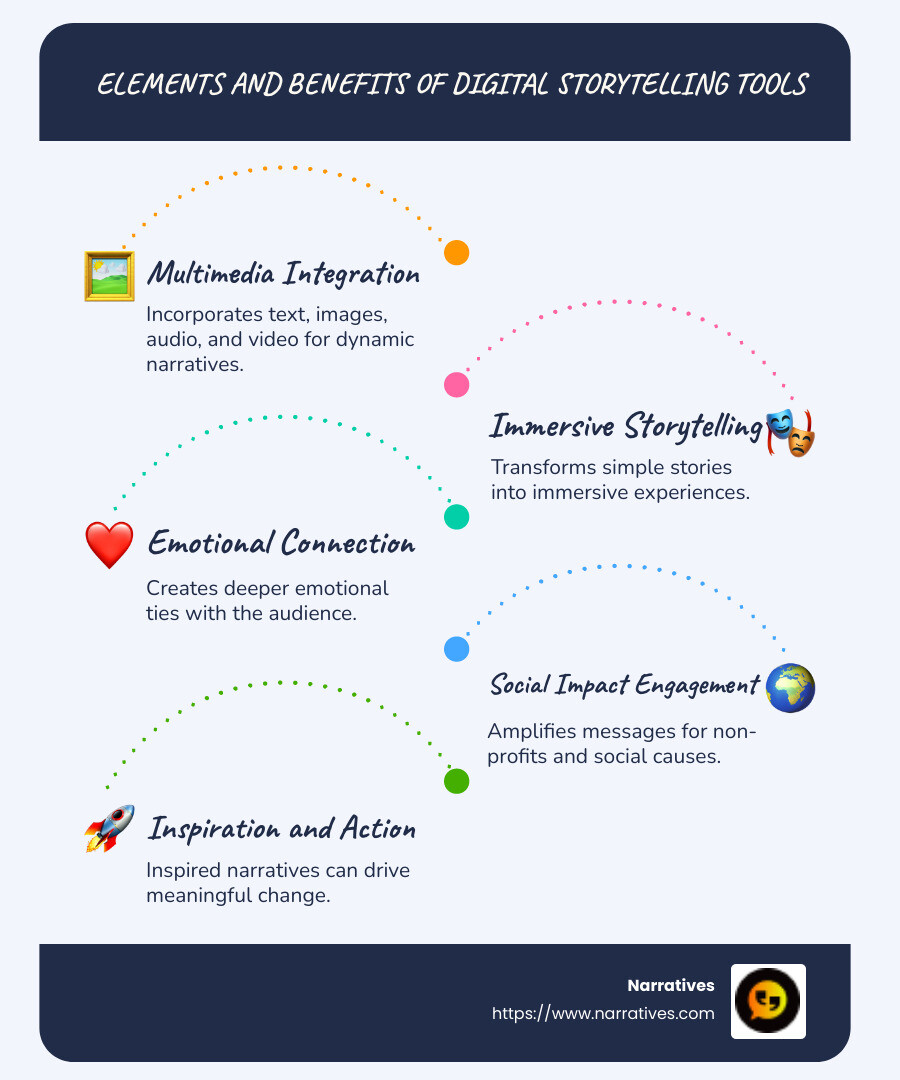Exploring the World of Digital Storytelling Tools

What is digital storytelling tools? At its core, digital storytelling tools empower us to weave narratives using multimedia elements like text, images, audio, and video. These tools transform storytelling from a simple tale into an immersive experience, helping convey messages more powerfully.
Digital storytelling is not just about sharing facts or figures; it's about creating a journey. With tools that improve multimedia narratives, stories have become more engaging and impactful. Whether you're explaining a complex concept, advocating for a cause, or simply sharing an trip, digital storytelling tools allow you to make your narrative come to life. This approach is especially key for non-profits and social impact organizations seeking to amplify their message.
Gone are the days when stories were conveyed by words alone. Today, videos, maps, and interactive graphics create rich narratives that can lead to greater emotional connections and inspire action. As emerging technologies continue to evolve, so do the methods and tools available to storytellers, enabling more dynamic and relatable content. This could be the perfect opportunity to lift your narrative.
By embracing digital storytelling, you can connect deeply with your audience, conveying stories that resonate and drive meaningful change.

Important what is digital storytelling tools terms:
- digital storytelling in education
- interactive digital storytelling examples
- online storytelling platform
What is Digital Storytelling Tools?
Understanding Digital Storytelling
Digital storytelling tools are like magic wands for storytellers. They help transform simple tales into exciting trips using a mix of multimedia elements—text, images, audio, and video. Imagine telling a story not just with words, but with the vibrant colors of a picture, the rhythm of a song, or the motion of a video. This is what digital storytelling is all about.
In the past, stories were mostly told through words. But now, digital media has opened the door to a world of creative possibilities. With tools like Canva and StoryMap JS, storytellers can craft narratives that are not only informative but also visually appealing and interactive. For instance, a timeline of historical events can come alive with TimelineJS, allowing readers to explore each event with images and videos, making the learning experience much richer.
Benefits of Digital Storytelling Tools
Digital storytelling tools bring several benefits that make them invaluable for anyone looking to communicate effectively:
Engagement: Stories told through multimedia are more engaging. They capture attention and keep readers interested. This is crucial in a world where information is abundant and attention spans are short.
Creativity: These tools open up creativity by allowing storytellers to experiment with different media. Whether it's designing a beautiful infographic with Piktochart or creating an interactive map with StoryMap JS, the possibilities are endless.
Education: In educational settings, digital storytelling tools can make learning more interactive and fun. By using tools like Canva to create visual aids or TimelineJS to explore historical events, students can better understand and retain information.
In conclusion, digital storytelling tools are not just about telling stories; they are about making stories come alive. They offer a dynamic way to engage, educate, and inspire audiences, turning simple narratives into memorable experiences.
Top Digital Storytelling Tools
In digital storytelling, several tools stand out for their ability to transform ideas into engaging multimedia experiences. Let's explore some of the top digital storytelling tools that can help you create captivating narratives.
Canva
Canva is a versatile tool for creating stunning visuals without the need for advanced graphic design skills. It offers a plethora of templates for social media posts, infographics, and presentations. With its drag-and-drop interface, anyone can feel like a professional designer. Canva is perfect for storytellers who want to add a visual punch to their narratives.
Adobe Spark
Adobe Spark is another fantastic tool for crafting beautiful, image-rich stories. It's particularly useful for short, linear stories that rely heavily on visuals. Spark Pages allow you to combine text with images and videos to create a seamless storytelling experience. While it doesn't support interactive content, it excels in creating visually appealing projects.
StoryMap JS
For those who wish to tell stories based on geographic locations, StoryMap JS is the go-to tool. It allows you to layer information—such as titles, text, images, and videos—over a map. This tool is excellent for creating narratives that guide readers through different locations, making them feel like they're part of the journey.
Timeline JS
Timeline JS is ideal for creating interactive timelines. By using a Google spreadsheet, you can incorporate videos, images, and audio files to tell a chronological story. This tool is perfect for educators and historians who want to bring historical events to life, providing a richer context for understanding the past.
Piktochart
Piktochart is a powerful tool for designing infographics. It offers a range of templates that make data visualization easy and effective. Whether you're showcasing research data or telling a story through numbers, Piktochart helps you communicate your message clearly and creatively.
These digital storytelling tools offer unique features to improve your storytelling capabilities. Whether you're creating a visual story with Canva or exploring historical events with Timeline JS, these tools help bring your narratives to life.
Using Digital Storytelling Tools in Education
Digital storytelling tools have become invaluable resources in education, enhancing both teaching and learning experiences. They foster interactive learning environments where students and teachers can explore creativity and engagement through storytelling.
Tools for Students
Bubblr
Bubblr is a simple yet effective tool for students to create comic strips using images from Flickr. It encourages creativity by allowing students to add speech bubbles and captions to their chosen images. This tool is perfect for visual learners and helps students express ideas in a fun and engaging way.
Comic Master
Comic Master offers students the chance to create their own graphic novels. With customizable panels, characters, and backgrounds, it allows students to craft detailed stories. This tool is excellent for developing narrative skills and can be used in projects across various subjects.
MakeBeliefsComix
MakeBeliefsComix is another fantastic comic strip creator that supports multiple languages, making it accessible to a broader range of students. It provides a user-friendly interface for creating comics, which can be used to illustrate stories, explain concepts, or even create language lessons.
Tools for Teachers
ZooBurst
ZooBurst is an interactive tool that allows teachers to create 3D pop-up books. It’s a great way to bring stories to life in the classroom, making reading and storytelling more engaging. Teachers can use it to create interactive lessons that captivate students' attention and encourage participation.
Storybird
Storybird focuses on inspiring students through art-inspired storytelling. Teachers can assign story projects where students write stories based on beautiful artwork. This tool promotes literacy and creativity, encouraging students to think critically about narrative structure and character development.
WeVideo
WeVideo is a powerful video editing tool that allows teachers to create and edit videos with ease. It’s perfect for creating multimedia presentations or video lessons. Teachers can also assign video projects to students, allowing them to demonstrate their understanding of a topic creatively.
These tools not only make learning more interactive but also empower students and teachers to explore storytelling in new and exciting ways. By integrating these digital storytelling tools into the classroom, educators can foster an environment where creativity and learning go hand in hand.
Frequently Asked Questions about Digital Storytelling Tools
What is digital storytelling tools used for?
Digital storytelling tools are versatile and used across various fields like education, marketing, and entertainment. In education, they improve learning by making lessons more interactive and engaging. Teachers use these tools to create content that captivates students' attention and encourages participation. For example, WeVideo allows teachers to create multimedia presentations that enrich classroom learning.
In marketing, digital storytelling tools help brands connect with their audience by crafting compelling narratives. Interactive content, like that created with Apester, engages consumers and encourages them to participate in the storytelling process. This approach makes marketing campaigns more memorable and effective.
In entertainment, these tools allow creators to produce rich, multimedia stories that captivate audiences. Whether it's through video, audio, or interactive elements, digital storytelling improves the way stories are told and experienced.
What are examples of digital storytelling tools?
Several tools stand out for their ability to create engaging digital stories. Canva is popular for its easy-to-use design features, making it ideal for creating visually appealing content like infographics and social media posts. Adobe Spark is another excellent tool for creating image-based stories, offering a gallery of ready-to-use images to bring stories to life. For geographic storytelling, StoryMap JS allows users to layer information over maps, perfect for telling stories centered around locations.
These tools highlight the diverse ways digital storytelling can be crafted, each suited to different storytelling needs and styles.
Are there free digital storytelling tools available?
Yes, there are many free digital storytelling tools available that make storytelling accessible and cost-effective. For instance, Piktochart offers free templates for crafting unique data visualizations, although customization options may be limited. ThingLink provides a basic free account for creating interactive images and videos, making it easier for educators and content creators to improve their stories without breaking the bank.
Free tools ensure that anyone, regardless of budget, can engage in digital storytelling. This accessibility encourages more people to share their narratives and connect with others through creative expression.
Conclusion
Narratives plays a vital role in empowering non-profits and purpose-driven organizations to amplify their stories. By leveraging digital storytelling tools, these organizations can create compelling narratives that resonate with their audiences and drive social impact.
Digital storytelling tools offer non-profits an opportunity to lift underrepresented voices and showcase the meaningful work they do in communities. These tools enable organizations to craft emotionally engaging content that not only informs but also inspires action. Whether it's through video, audio, or interactive elements, digital storytelling helps build trust and increase visibility for non-profits.
Community storytelling is at the heart of what Narratives does. By focusing on the stories of individuals and communities, we help non-profits connect with their audience on a deeper level. This connection is crucial for fostering empathy and encouraging support for the causes that matter most.
As we continue to explore digital storytelling, it's clear that these tools are more than just a means to an end. They are a powerful way to create change, build community, and make a lasting impact. If you're part of a non-profit or purpose-driven organization looking to share your story, consider partnering with us at Narratives to lift your message and inspire action. Together, we can make a difference.



